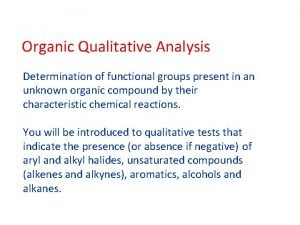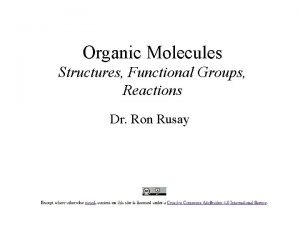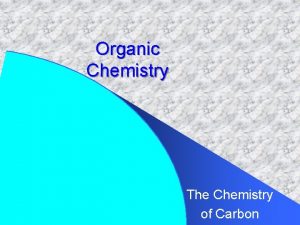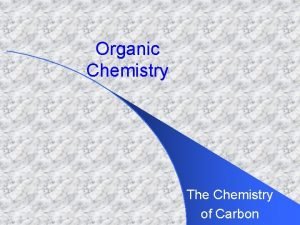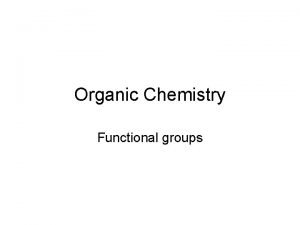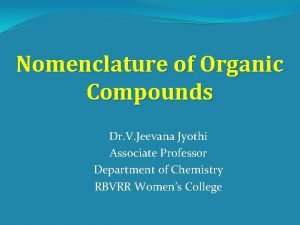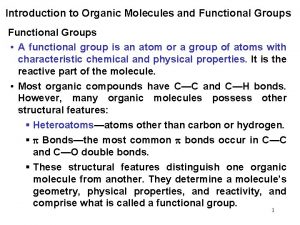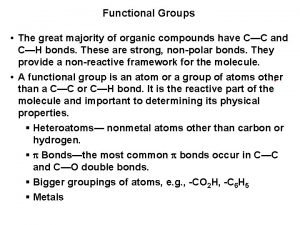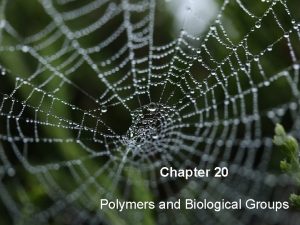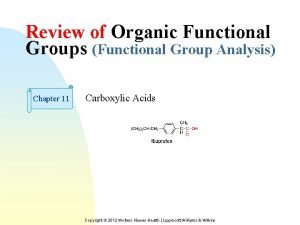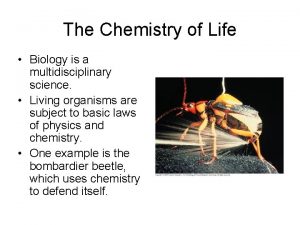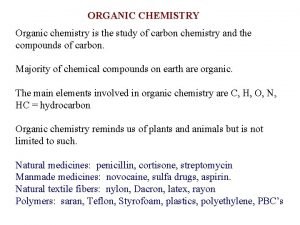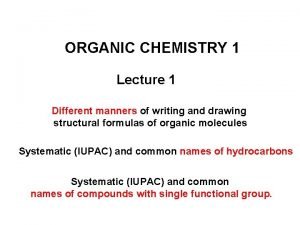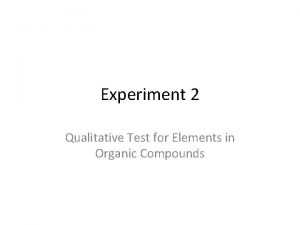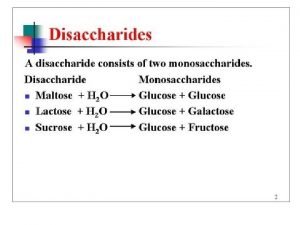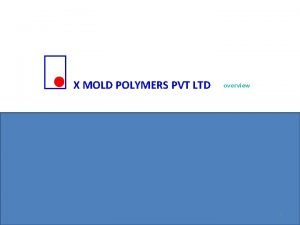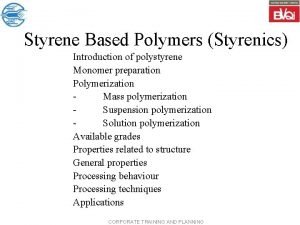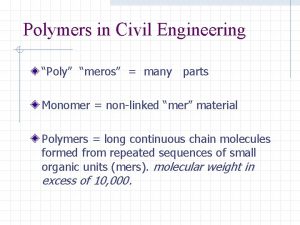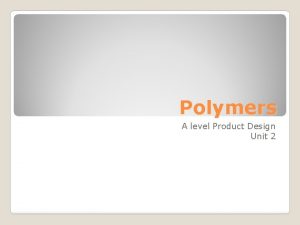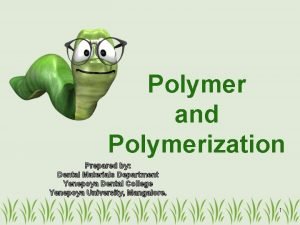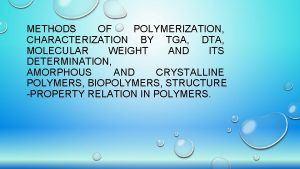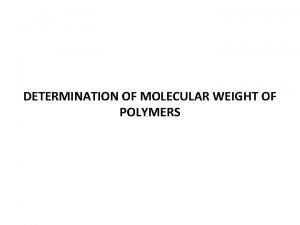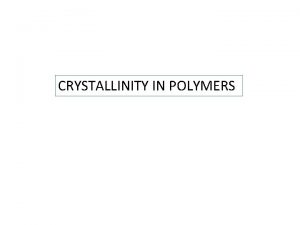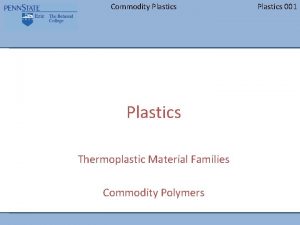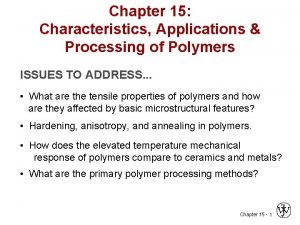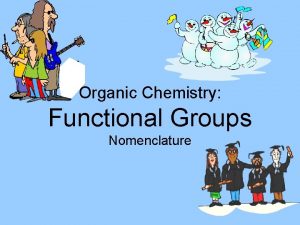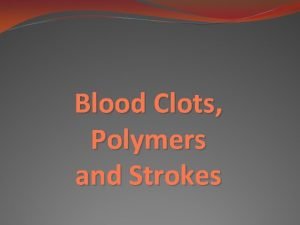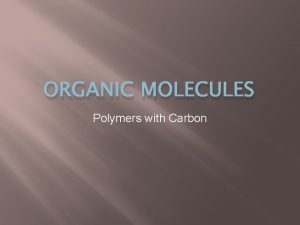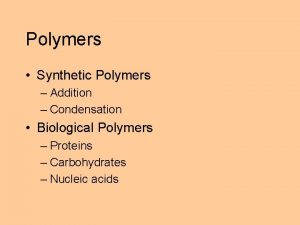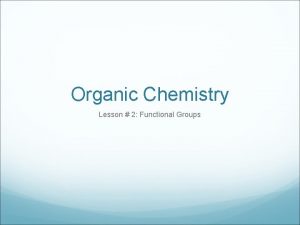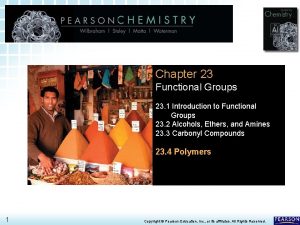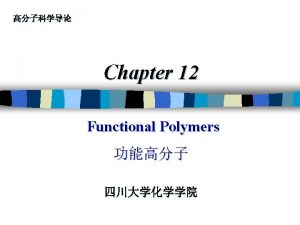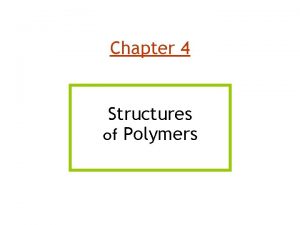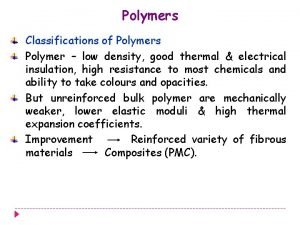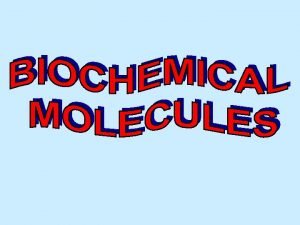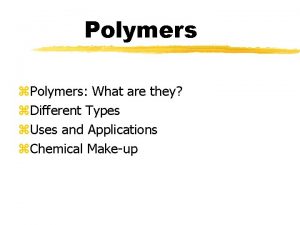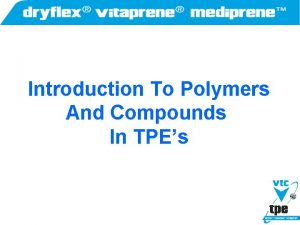23 4 Polymers Chapter 23 Functional Groups 23










































- Slides: 42

23. 4 Polymers > Chapter 23 Functional Groups 23. 1 Introduction to Functional Groups 23. 2 Alcohols, Ethers, and Amines 23. 3 Carbonyl Compounds 23. 4 Polymers 1 Copyright © Pearson Education, Inc. , or its affiliates. All Rights Reserved.

23. 4 Polymers > CHEMISTRY & YOU How do organic molecules bond together to form long chains? Similar to the way these skydivers are linked together in a chain, organic molecules can bond together to form long molecular chains. 2 Copyright © Pearson Education, Inc. , or its affiliates. All Rights Reserved.

23. 4 Polymers > Addition Polymers How does an addition polymer form? 3 Copyright © Pearson Education, Inc. , or its affiliates. All Rights Reserved.

23. 4 Polymers > Addition Polymers Some of the most important organic compounds that exist are giant molecules called polymers. • For example, the materials you know as plastics are polymers. 4 Copyright © Pearson Education, Inc. , or its affiliates. All Rights Reserved.

23. 4 Polymers > Addition Polymers A polymer is a large molecule formed by the covalent bonding of repeating smaller molecules. • The smaller molecules that combine to form a polymer are called monomers. • Some polymers contain only one type of monomer. • Others contain two or more types. 5 Copyright © Pearson Education, Inc. , or its affiliates. All Rights Reserved.

23. 4 Polymers > Addition Polymers The reaction that joins monomers to form a polymer is called polymerization. • Most polymerization reactions require a catalyst. 6 Copyright © Pearson Education, Inc. , or its affiliates. All Rights Reserved.

23. 4 Polymers > Addition Polymers An addition polymer forms when unsaturated monomers react to form a polymer. 7 Copyright © Pearson Education, Inc. , or its affiliates. All Rights Reserved.

23. 4 Polymers > Addition Polymers An addition polymer forms when unsaturated monomers react to form a polymer. • Ethene undergoes addition polymerization. – The ethene molecules bond to one another to form the long-chain polymer polyethylene, as described in the equation below. 8 Copyright © Pearson Education, Inc. , or its affiliates. All Rights Reserved.

23. 4 Polymers > Addition Polymers • Note that the letter x on the reactant side of the equation refers to the number of monomers (in this case, ethene) that combine to form the polymer. • Parentheses are used to identify the repeating unit (in this case, —CH 2—CH 2). 9 Copyright © Pearson Education, Inc. , or its affiliates. All Rights Reserved.

23. 4 Polymers > Addition Polymers Polyethylene, which is chemically resistant and easy to clean, is an important industrial product. • It is used to make plastic bottles, containers, and even toys. 10 Copyright © Pearson Education, Inc. , or its affiliates. All Rights Reserved.

23. 4 Polymers > Addition Polymers The physical properties of polyethylene can be controlled by shortening or lengthening the carbon chains. • Polyethylene that contains relatively short chains (x = 100) has the consistency of paraffin wax. • Polyethylene with long chains (x = 1000) is harder and more rigid. 11 Copyright © Pearson Education, Inc. , or its affiliates. All Rights Reserved.

23. 4 Polymers > Addition Polymers Polypropylene, a stiffer polymer than polyethylene, is used extensively in utensils and beverage containers. • Polypropylene is prepared by the polymerization of propene. 12 Copyright © Pearson Education, Inc. , or its affiliates. All Rights Reserved.

23. 4 Polymers > Addition Polymers Polystyrene, in the form of a rigid foam, is a poor heat conductor. • This makes it useful for insulating homes and for manufacturing molded items such as coffee cups and picnic coolers. • Polystyrene is prepared by the polymerization of styrene. Polystyrene foam is used to make protective helmets. 13 Copyright © Pearson Education, Inc. , or its affiliates. All Rights Reserved.

23. 4 Polymers > Addition Polymers Many halocarbon polymers, including polyvinyl chloride (PVC), have useful properties. • Polyvinyl chloride is used to make plumbing pipes, rainwear, and garden hoses. • Vinyl chloride is the monomer of polyvinyl chloride. 14 Copyright © Pearson Education, Inc. , or its affiliates. All Rights Reserved.

23. 4 Polymers > Addition Polymers Polytetrafluoroethene (PTFE) is the product of the polymerization of tetrafluoroethene monomers. • You are probably familiar with this polymer as a coating on nonstick cookware. • PTFE is very durable and slick. • It is also suspended in motor oils as a frictionreducing agent. Tetrafluoroethene 15 PTFE Copyright © Pearson Education, Inc. , or its affiliates. All Rights Reserved.

23. 4 Polymers > Addition Polymers Polyisoprene is the polymer that constitutes natural rubber. • The monomer of polyisoprene, is harvested from tropical plants such as the rubber tree. • Polyisoprene is used to make rubber bands, soles of athletic shoes, and many other common items. 16 Copyright © Pearson Education, Inc. , or its affiliates. All Rights Reserved.

23. 4 Polymers > Addition Polymers Rubber is harvested from tropical plants. Harvesters cut the trees, and the sap, which contains isoprene, is collected. As the rubber dries, the isoprene polymerizes and changes form. Finally, the manufacturer processes and molds the polymer to form the desired product. 17 Copyright © Pearson Education, Inc. , or its affiliates. All Rights Reserved.

23. 4 Polymers > What are the smaller molecules that join together to form a polymer called? 18 Copyright © Pearson Education, Inc. , or its affiliates. All Rights Reserved.

23. 4 Polymers > What are the smaller molecules that join together to form a polymer called? The smaller molecules that join together to form a polymer are called monomers. 19 Copyright © Pearson Education, Inc. , or its affiliates. All Rights Reserved.

23. 4 Polymers > Condensation Polymers How are condensation polymers formed? 20 Copyright © Pearson Education, Inc. , or its affiliates. All Rights Reserved.

23. 4 Polymers > Condensation Polymers Condensation polymers are formed by the joining of monomers with the loss of a small molecule such as water. 21 Copyright © Pearson Education, Inc. , or its affiliates. All Rights Reserved.

23. 4 Polymers > Condensation Polymers Polyesters are polymers that consist of many repeating units of dicarboxylic acids and dihydroxy alcohols joined by ester bonds. • The formation of a polyester can be represented by a block diagram, which shows only the functional groups involved. 22 Copyright © Pearson Education, Inc. , or its affiliates. All Rights Reserved.

23. 4 Polymers > Condensation Polymers Polyesters are polymers that consist of many repeating units of dicarboxylic acids and dihydroxy alcohols joined by ester bonds. • The squares and circles represent unreactive parts of the organic molecules. 23 Copyright © Pearson Education, Inc. , or its affiliates. All Rights Reserved.

23. 4 Polymers > Condensation Polymers Polyesters are polymers that consist of many repeating units of dicarboxylic acids and dihydroxy alcohols joined by ester bonds. • Condensation polymerization requires that there be two functional groups on each monomer molecule. 24 Copyright © Pearson Education, Inc. , or its affiliates. All Rights Reserved.

23. 4 Polymers > Condensation Polymers The polyester polyethylene terephthalate (PET) is formed from terephthalic acid and ethylene glycol. 25 Copyright © Pearson Education, Inc. , or its affiliates. All Rights Reserved.

23. 4 Polymers > Condensation Polymers The fabric of the jacket is made from recycled PET bottles. • It only takes about a dozen large bottles that are made from PET to make one fleece jacket. 26 • PET fibers are often blended with cotton to make clothing that is more comfortable on hot, humid days than those containing 100% polyester. Copyright © Pearson Education, Inc. , or its affiliates. All Rights Reserved.

23. 4 Polymers > Condensation Polymers • Woven PET fiber tubing can be used to replace major blood vessels. • PET melts may also be forced through a narrow slit to produce sheets of film that are used extensively on credit cards and as coverings for frozen dinners. 27 Copyright © Pearson Education, Inc. , or its affiliates. All Rights Reserved.

23. 4 Polymers > CHEMISTRY & YOU Polymers make up most of the bottles, containers, and packaging that you see around you. Try to identify the polymers in some of these items. How would you classify them—as addition polymers or condensation polymers? 28 Copyright © Pearson Education, Inc. , or its affiliates. All Rights Reserved.

23. 4 Polymers > CHEMISTRY & YOU Polymers make up most of the bottles, containers, and packaging that you see around you. Try to identify the polymers in some of these items. How would you classify them—as addition polymers or condensation polymers? • A soda bottle is made of PET, a condensation polymer. • A styrofoam cup is made of polystyrene, an addition polymer. 29 Copyright © Pearson Education, Inc. , or its affiliates. All Rights Reserved.

23. 4 Polymers > Condensation Polymers Many important polymers are formed by the reaction of carboxylic acids and amines. • The amines used to make polymers generally contain the amino functional group (—NH 2). • The condensation of a carboxylic acid an amine produces an amide. 30 Copyright © Pearson Education, Inc. , or its affiliates. All Rights Reserved.

23. 4 Polymers > Condensation Polymers Polyamides are polymers in which the carboxylic acid and amine monomer units are linked by amide bonds. • The many types of nylon are polyamides. – The representative polymer unit of nylon is derived from 6 -aminohexanoic acid, a compound that contains both carboxyl and amino functional groups. 31 Copyright © Pearson Education, Inc. , or its affiliates. All Rights Reserved.

23. 4 Polymers > Condensation Polymers Polyamides are polymers in which the carboxylic acid and amine monomer units are linked by amide bonds. • The many types of nylon are polyamides. – The long polymer chain is formed by the successive attachment of the carboxyl group of one molecule of the monomer to the amino group of the next monomer by the formation of an amide bond. 32 Copyright © Pearson Education, Inc. , or its affiliates. All Rights Reserved.

23. 4 Polymers > Condensation Polymers The melted polymer can be spun into very fine, yet very strong, fibers. • Nylon fibers are used for carpeting, tire cord, fishing lines, sheer hosiery, and textiles. • Nylon is also molded into gears, bearings, zippers, and ropes. – Many climbers use climbing rope with cores that are composed of nylon. 33 Copyright © Pearson Education, Inc. , or its affiliates. All Rights Reserved.

23. 4 Polymers > Condensation Polymers Polyamides that contain aromatic rings are extremely tough and flame resistant. • Kevlar. TM is a polyamide with a carbon skeleton consisting of aromatic rings derived from terephthalic acid and p-phenylenediamine. – A properly constructed vest made of Kevlar is strong enough to stop high-speed bullets, yet is light and flexible enough to be worn under normal clothing. 34 Copyright © Pearson Education, Inc. , or its affiliates. All Rights Reserved.

23. 4 Polymers > Condensation Polymers Nomex. TM is another polyamide that contains aromatic rings. • It is used in the fabrication of flame-resistant building materials and in the manufacture of the flame-resistant clothing firefighters wear. 35 Copyright © Pearson Education, Inc. , or its affiliates. All Rights Reserved.

23. 4 Polymers > Condensation Polymers Nomex. TM is another polyamide that contains aromatic rings. • Nomex is a polyamide made from isophthalic acid and m-phenylenediamine. 36 Copyright © Pearson Education, Inc. , or its affiliates. All Rights Reserved.

23. 4 Polymers > What is a major difference between the formation of addition polymers and condensation polymers? 37 Copyright © Pearson Education, Inc. , or its affiliates. All Rights Reserved.

23. 4 Polymers > What is a major difference between the formation of addition polymers and condensation polymers? A small molecule such as water is lost when monomers join to form a condensation polymer, so each monomer of a condensation polymer must have two functional groups. 38 Copyright © Pearson Education, Inc. , or its affiliates. All Rights Reserved.

23. 4 Polymers > Key Concepts An addition polymer forms when unsaturated monomers react to form a polymer. Condensation polymers are formed by the joining of monomers with the loss of a small molecule such as water. 39 Copyright © Pearson Education, Inc. , or its affiliates. All Rights Reserved.

23. 4 Polymers > Glossary Terms • polymer: a very large molecule formed by the covalent bonding of repeating small molecules, known as monomers • monomer: a simple molecule that repeatedly combines to form a polymer 40 Copyright © Pearson Education, Inc. , or its affiliates. All Rights Reserved.

23. 4 Polymers > BIG IDEA Carbon Chemistry and Reactions Polymerization reactions are commonly used in organic chemistry. 41 Copyright © Pearson Education, Inc. , or its affiliates. All Rights Reserved.

23. 4 Polymers > END OF 23. 4 42 Copyright © Pearson Education, Inc. , or its affiliates. All Rights Reserved.
 How are ethnic groups and religious groups related
How are ethnic groups and religious groups related Qualitative analysis of organic functional groups
Qualitative analysis of organic functional groups Functional groups in aspirin
Functional groups in aspirin Chrial vs achiral
Chrial vs achiral Priority of functional groups
Priority of functional groups Ch3ch2cooch2ch3
Ch3ch2cooch2ch3 Epoxides
Epoxides Order of priority of functional groups
Order of priority of functional groups Functional departmentalization groups jobs by
Functional departmentalization groups jobs by Functional group
Functional group Intermolecular forces of functional groups
Intermolecular forces of functional groups Rx functional group
Rx functional group Functional groups
Functional groups Hydrophobic functional groups
Hydrophobic functional groups Ib chemistry organic chemistry
Ib chemistry organic chemistry Polypropylene functional groups
Polypropylene functional groups Functional groups of muscles
Functional groups of muscles Cooh functional group
Cooh functional group Functional groups poster
Functional groups poster Functional groups biology
Functional groups biology Organic chemistry
Organic chemistry Esteroic
Esteroic Alkene functional group
Alkene functional group R-c-o-r functional group
R-c-o-r functional group Ferrox paper test for oxygen
Ferrox paper test for oxygen Beta-acetal linkages
Beta-acetal linkages Removable non functional space maintainer
Removable non functional space maintainer Non functional plasma enzyme example
Non functional plasma enzyme example Enzymes of blood plasma
Enzymes of blood plasma Functional and non functional
Functional and non functional Xmold
Xmold Water soluble antiscalant polymers
Water soluble antiscalant polymers Styrene synthesis
Styrene synthesis Why do different polymers have different properties
Why do different polymers have different properties Disadvantages of thermoplastics
Disadvantages of thermoplastics 2 types of plastic
2 types of plastic Polymers in dental materials
Polymers in dental materials Homochain polymers
Homochain polymers Polymer molecular weight determination
Polymer molecular weight determination Crystallinity
Crystallinity Types of commodity plastics
Types of commodity plastics Www.chemsheets.co.uk
Www.chemsheets.co.uk Application and processing of polymers
Application and processing of polymers

